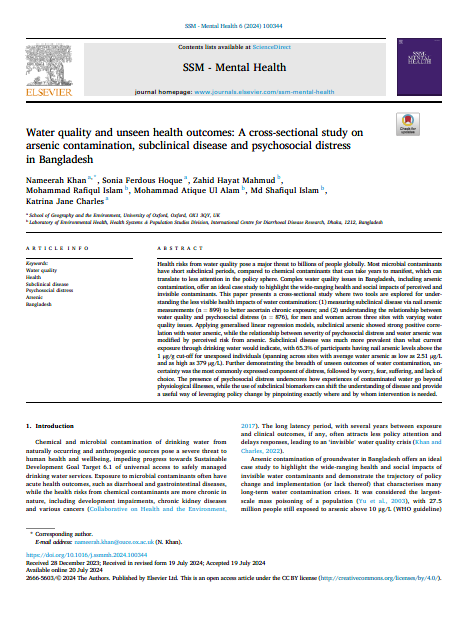Authors: Nameerah Khan, Sonia Ferdous Hoque, Zahid Hayat Mahmud, Mohammad Rafiqul Islam, Mohammad Atique Ul Alam, Md Shafiqul Islam, Katrina Charles
Health risks from water quality pose a major threat to billions of people globally. Most microbial contaminants have short subclinical periods, compared to chemical contaminants that can take years to manifest, which can translate to less attention in the policy sphere. Complex water quality issues in Bangladesh, including arsenic contamination, offer an ideal case study to highlight the wide-ranging health and social impacts of perceived and invisible contaminants. This paper presents a cross-sectional study where two tools are explored for understanding the less visible health impacts of water contamination: (1) measuring subclinical disease via nail arsenic measurements (n = 899) to better ascertain chronic exposure; and (2) understanding the relationship between water quality and psychosocial distress (n = 876), for men and women across three sites with varying water quality issues. Applying generalised linear regression models, subclinical arsenic showed strong positive correlation with water arsenic, while the relationship between severity of psychosocial distress and water arsenic was modified by perceived risk from arsenic. Subclinical disease was much more prevalent than what current exposure through drinking water would indicate, with 65.3% of participants having nail arsenic levels above the 1 μg/g cut-off for unexposed individuals (spanning across sites with average water arsenic as low as 2.51 μg/L and as high as 379 μg/L). Further demonstrating the breadth of unseen outcomes of water contamination, uncertainty was the most commonly expressed component of distress, followed by worry, fear, suffering, and lack of choice. The presence of psychosocial distress underscores how experiences of contaminated water go beyond physiological illnesses, while the use of subclinical biomarkers can shift the understanding of disease and provide a useful way of leveraging policy change by pinpointing exactly where and by whom intervention is needed.

